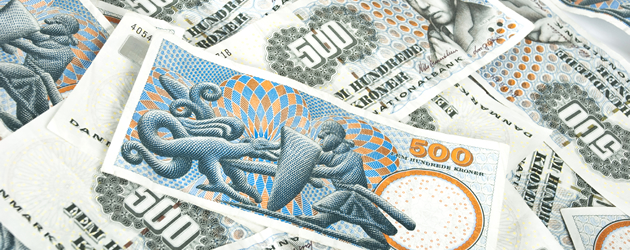The Euro was steady against the Danish Krone, stronger against the Swedish Krona and weaker against the Norwegian Krone on Friday. Meanwhile the single currency remained under pressure from ongoing concerns over Greece.
The Euro to Danish Krone (EUR/DKK) exchange rate was trading in the region of 7.4602
The Danish Krone was supported by Gross Domestic Product, which met economist expectations. According to the Denmark’s statistics office, the national economy expanded by 0.4% in the first quarter of 2015.
Growth was shown to have been supported by a rise in exports and an increase in household consumption.
‘The first months of 2015 has certainly offered a range of positive key figures. Employment grows, consumer confidence is getting close to a record high, export and industrial production took a decent leap in March, price gains in the real estate market are spreading throughout the country and debit card revenues have increased,’ said analyst Tore Stramer.
The Euro to Swedish Krona (EUR/SEK) exchange rate climbed to a session high of 9.3029
The Swedish Krona weakened as GDP data disappointed.
The data showed that the Swedish economy expanded by just 0.4% in the first quarter, below economist expectations for 0.6% and far short of the 1.1% growth rate seen in the preceding quarter.
On an annual basis, the Swedish economy’s expansion slowed from 2.7% to 2.6%.
Following the release of the data, the Krona began to slide against the majority of its most traded peers.
The Euro to Norwegian Krone (EUR/NOK) exchange rate fell to a session low of 8.4762
The Euro weakened against the Norwegian Krone as data showed that retail sales in Norway surged higher by 2% on a month on month basis in April. The rise was a sharp increase on March’s figure of 0.3% and beat economist forecasts for 0.17%.
‘Most industries had an increase in sales volume from March to April this year. Sales in grocery stores made a particular contribution to the growth. Grocery stores contributed about 38 per cent of total turnover in retail sales. Sales of ICT equipment, sports and leisure equipment, clothing and footwear, and sales via mail order and the Internet also contributed to the increase from March to April this year. Sales at petrol stations and stores selling telecommunication equipment however, had a decrease during this period,’ said statistics Norway.
On a year-on-year basis sales were -1.93% lower in April, below expectations for 3.53%.
The Norwegian Krone also received support from firmer oil prices. The commodity’s value rose as data showed that crude stocks in the US fell for a fourth consecutive week.



